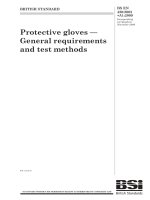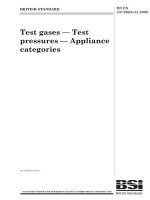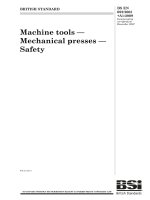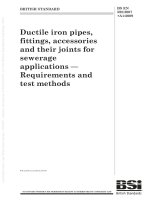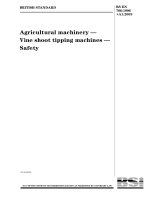Bsi bs en 62453 303 2 2009
Bạn đang xem bản rút gọn của tài liệu. Xem và tải ngay bản đầy đủ của tài liệu tại đây (1.8 MB, 36 trang )
Licensed Copy: athen reading, Reading University Library, 23/01/2010 05:47, Uncontrolled Copy, (c) BSI
BS EN 62453-303-2:2009
BSI Standards Publication
Field device tool (FDT) interface
specification —
Part 303-2: Communication profile integration —
IEC 61784 CP 3/4, CP 3/5 and CP 3/6
NO COPYING WITHOUT BSI PERMISSION EXCEPT AS PERMITTED BY COPYRIGHT LAW
raising standards worldwide™
BRITISH STANDARD
Licensed Copy: athen reading, Reading University Library, 23/01/2010 05:47, Uncontrolled Copy, (c) BSI
BS EN 62453-303-2:2009
National foreword
This British Standard is the UK implementation of EN 62453-303-2:2009. It is
identical to IEC 62453-303-2:2009.
The UK participation in its preparation was entrusted to Technical Committee
AMT/7, Industrial communications: process measurement and control,
including fieldbus.
A list of organizations represented on this committee can be obtained on
request to its secretary.
This publication does not purport to include all the necessary provisions of a
contract. Users are responsible for its correct application.
© BSI 2010
ISBN 978 0 580 62563 3
ICS 25.040.40; 35.100.05; 35.110
Compliance with a British Standard cannot confer immunity from
legal obligations.
This British Standard was published under the authority of the Standards
Policy and Strategy Committee on 31 January 2010
Amendments issued since publication
Amd. No.
Date
标准分享网 www.bzfxw.com 免费下载
Text affected
Licensed Copy: athen reading, Reading University Library, 23/01/2010 05:47, Uncontrolled Copy, (c) BSI
BS EN 62453-303-2:2009
EUROPEAN STANDARD
EN 62453-303-2
NORME EUROPÉENNE
October 2009
EUROPÄISCHE NORM
ICS 25.040.40; 35.100.05; 35.110
English version
Field device tool (FDT) interface specification Part 303-2: Communication profile integration IEC 61784 CP 3/4, CP 3/5 and CP 3/6
(IEC 62453-303-2:2009)
Spécification des interfaces des outils
des dispositifs de terrain (FDT) Partie 303-2: Intégration des profils
de communication CEI 61784 CP 3/4, CP 3/5 et CP 3/6
(CEI 62453-303-2:2009)
Field Device Tool (FDT)Schnittstellenspezifikation Teil 303-2: Integration
von Kommunikationsprofilen Kommunikationsprofile (CP)
3/4, 3/5 und 3/6 nach IEC 61784
(IEC 62453-303-2:2009)
www.bzfxw.com
This European Standard was approved by CENELEC on 2009-08-01. CENELEC members are bound to comply
with the CEN/CENELEC Internal Regulations which stipulate the conditions for giving this European Standard
the status of a national standard without any alteration.
Up-to-date lists and bibliographical references concerning such national standards may be obtained on
application to the Central Secretariat or to any CENELEC member.
This European Standard exists in three official versions (English, French, German). A version in any other
language made by translation under the responsibility of a CENELEC member into its own language and notified
to the Central Secretariat has the same status as the official versions.
CENELEC members are the national electrotechnical committees of Austria, Belgium, Bulgaria, Cyprus, the
Czech Republic, Denmark, Estonia, Finland, France, Germany, Greece, Hungary, Iceland, Ireland, Italy, Latvia,
Lithuania, Luxembourg, Malta, the Netherlands, Norway, Poland, Portugal, Romania, Slovakia, Slovenia, Spain,
Sweden, Switzerland and the United Kingdom.
CENELEC
European Committee for Electrotechnical Standardization
Comité Européen de Normalisation Electrotechnique
Europäisches Komitee für Elektrotechnische Normung
Central Secretariat: Avenue Marnix 17, B - 1000 Brussels
© 2009 CENELEC -
All rights of exploitation in any form and by any means reserved worldwide for CENELEC members.
Ref. No. EN 62453-303-2:2009 E
Licensed Copy: athen reading, Reading University Library, 23/01/2010 05:47, Uncontrolled Copy, (c) BSI
BS EN 62453-303-2:2009
EN 62453-303-2:2009
-2-
Foreword
The text of document 65E/128/FDIS, future edition 1 of IEC 62453-303-2, prepared by SC 65E, Devices and
integration in enterprise systems, of IEC TC 65, Industrial-process measurement, control and automation,
was submitted to the IEC-CENELEC parallel vote and was approved by CENELEC as EN 62453-303-2 on
2009-08-01.
Each part of the EN 62453-3xy series is intended to be read in conjunction with EN 62453-2.
The following dates were fixed:
– latest date by which the EN has to be implemented
at national level by publication of an identical
national standard or by endorsement
(dop)
2010-05-01
– latest date by which the national standards conflicting
with the EN have to be withdrawn
(dow)
2012-08-01
Annex ZA has been added by CENELEC.
__________
Endorsement notice
The text of the International Standard IEC 62453-303-2:2009 was approved by CENELEC as a European
Standard without any modification.
In the official version, for Bibliography, the following note has to be added for the standard indicated:
IEC 61158
www.bzfxw.com
NOTE Harmonized in EN 61158 series (not modified).
__________
标准分享网 www.bzfxw.com 免费下载
Licensed Copy: athen reading, Reading University Library, 23/01/2010 05:47, Uncontrolled Copy, (c) BSI
-3-
BS EN 62453-303-2:2009
EN 62453-303-2:2009
Annex ZA
(normative)
Normative references to international publications
with their corresponding European publications
The following referenced documents are indispensable for the application of this document. For dated
references, only the edition cited applies. For undated references, the latest edition of the referenced
document (including any amendments) applies.
NOTE When an international publication has been modified by common modifications, indicated by (mod), the relevant EN/HD
applies.
Publication
Year
Title
EN/HD
Year
IEC 61158-5-10
–
1)
IEC 61158-6-10
–
1)
Industrial communication networks Fieldbus specifications Part 6-10: Application layer protocol
specification - Type 10 elements
IEC 61784-2
–
1)
EN 61784-2
Industrial communication networks Profiles Part 2: Additional fieldbus profiles for real-time
networks based on ISO/IEC 8802-3
2008
IEC 62453-1
2009
Field device tool (FDT) interface specification - EN 62453-1
Part 1: Overview and guidance
2009
2009
Field device tool (FDT) interface specification - EN 62453-2
Part 2: Concepts and detailed description
2009
IEC 62453-2
EN 61158-5-10
Industrial communication networks Fieldbus specifications Part 5-10: Application layer service definition Type 10 elements
2008
2)
2008
2)
2)
EN 61158-6-10
www.bzfxw.com
1)
Undated reference.
2)
Valid edition at date of issue.
Licensed Copy: athen reading, Reading University Library, 23/01/2010 05:47, Uncontrolled Copy, (c) BSI
BS EN 62453-303-2:2009
–2–
62453-303-2 © IEC:2009(E)
CONTENTS
INTRODUCTION.....................................................................................................................6
1
Scope ...............................................................................................................................7
2
Normative references .......................................................................................................7
3
Terms, definitions, symbols, abbreviated terms and conventions ...................................... 7
3.1
3.2
3.3
4
Terms and definitions ..............................................................................................7
Abbreviated terms ...................................................................................................8
Conventions ............................................................................................................8
3.3.1 Data type names and references to data types ............................................8
3.3.2 Vocabulary for requirements ........................................................................8
3.3.3 Use of UML .................................................................................................8
Bus category ....................................................................................................................8
5
Access instance and device data ......................................................................................9
6
5.1 Process Channel objects provided by DTM..............................................................9
5.2 DTM services to access instance and device data ...................................................9
Protocol specific behavior.................................................................................................9
7
Protocol specific usage of general data types ...................................................................9
8
Protocol specific common data types .............................................................................. 11
9
Network management data types .................................................................................... 11
www.bzfxw.com
9.1 General ................................................................................................................. 11
9.2 Parameter access data types ................................................................................ 11
10 Communication data types ............................................................................................. 17
11 Channel parameter data types ........................................................................................ 20
12 Device identification ....................................................................................................... 23
12.1 Protocol specific handling of data type STRING .................................................... 23
12.2 Device type identification data types ..................................................................... 23
12.3 Topology scan data types ...................................................................................... 26
12.4 Scan identification data types ................................................................................ 27
12.5 Device type identification data types ..................................................................... 29
Bibliography.......................................................................................................................... 32
Figure 1 – Part 303-2 of the IEC 62453 series ........................................................................6
Table 1 – Protocol identifier ....................................................................................................8
Table 2 – Physical layer identifier ...........................................................................................8
Table 3 – Protocol specific usage of general data types ..........................................................9
Table 4 – Simple parameter access data types ..................................................................... 11
Table 5 – Structured parameter access data types................................................................ 14
Table 6 – Simple communication data types ......................................................................... 17
Table 7 – Structured communication data types .................................................................... 18
Table 8 – Simple channel parameter data types .................................................................... 21
Table 9 – Structured channel parameter data types .............................................................. 22
Table 10 – Identification data types for PROFINET with pure DCP ........................................ 24
标准分享网 www.bzfxw.com 免费下载
Licensed Copy: athen reading, Reading University Library, 23/01/2010 05:47, Uncontrolled Copy, (c) BSI
BS EN 62453-303-2:2009
62453-303-2 © IEC:2009(E)
–3–
Table 11 – Identification data types for PROFINET with I&M ................................................. 25
Table 12 – Simple identification data types with protocol independent semantics .................. 26
Table 13 – Structured identification data types with protocol independent semantics ............ 26
Table 14 – Simple device type identification data types ........................................................ 26
Table 15 – Structured device type identification data type..................................................... 27
Table 16 – Simple scan identification data types ................................................................... 27
Table 17 – Structured scan identification data types ............................................................. 28
Table 18 – Structured device type identification data types ................................................... 29
www.bzfxw.com
Licensed Copy: athen reading, Reading University Library, 23/01/2010 05:47, Uncontrolled Copy, (c) BSI
BS EN 62453-303-2:2009
–6–
62453-303-2 © IEC:2009(E)
INTRODUCTION
This part of IEC 62453 is an interface specification for developers of FDT (Field Device Tool)
components for function control and data access within a client/server architecture. The
specification is a result of an analysis and design process to develop standard interfaces to
facilitate the development of servers and clients by multiple vendors that need to interoperate
seamlessly.
With the integration of fieldbusses into control systems, there are a few other tasks which
need to be performed. In addition to fieldbus- and device-specific tools, there is a need to
integrate these tools into higher-level system-wide planning- or engineering tools. In
particular, for use in extensive and heterogeneous control systems, typically in the area of the
process industry, the unambiguous definition of engineering interfaces that are easy to use for
all those involved is of great importance.
A device-specific software component, called DTM (Device Type Manager), is supplied by the
field device manufacturer with its device. The DTM is integrated into engineering tools via the
FDT interfaces defined in this specification. The approach to integration is in general open for
all kinds of fieldbusses and thus meets the requirements for integrating different kinds of
devices into heterogeneous control systems.
Figure 1 shows how IEC 62453-303-2 is aligned in the structure of the IEC 62453 series.
www.bzfxw.com
Part 303-2
Communication
profile integration –
IEC 61784 CP 3/4,
CP 3/5 and CP 3/6
IEC
1132/09
Figure 1 – Part 303-2 of the IEC 62453 series
标准分享网 www.bzfxw.com 免费下载
Licensed Copy: athen reading, Reading University Library, 23/01/2010 05:47, Uncontrolled Copy, (c) BSI
BS EN 62453-303-2:2009
62453-303-2 © IEC:2009(E)
–7–
FIELD DEVICE TOOL (FDT) INTERFACE SPECIFICATION –
Part 303-2: Communication profile integration –
IEC 61784 CP 3/4, CP 3/5 and CP 3/6
1
Scope
Communication Profile 3/4, Communication Profile 3/5 and Communication Profile 3/6
(commonly known as PROFINET® 1 IO) define communication profiles based on
IEC 61158-5-10 and IEC 61158-6-10. The basic profiles CP 3/4, CP 3/5, and CP 3/6 are
defined in IEC 61784-2.
This part of IEC 62453 provides information for integrating the PROFINET® technology into
the FDT interface (IEC 62453-2).
This part of the IEC 62453 specifies communication and other services.
This specification neither contains the FDT specification nor modifies it.
2
Normative references
www.bzfxw.com
The following referenced documents are indispensable for the application of this specification.
For dated references, only the edition cited applies. For undated references, the latest edition
of the referenced document (including any amendments) applies
IEC 61158-5-10, Industrial communication networks – Fieldbus specifications – Part 5-10:
Application layer service definition – Type 10 elements
IEC 61158-6-10, Industrial communication networks – Fieldbus specifications – Part 6-10:
Application layer protocol specification – Type 10 elements
IEC 61784-2 Industrial communication networks - Profiles - Part 2: Additional fieldbus profiles
for real-time networks based on ISO/IEC 8802-3
IEC 62453-1:2009,
guidance
Field Device Tool (FDT) interface specification – Part 1: Overview and
IEC 62453-2:2009, Field Device Tool (FDT) interface specification – Part 2: Concepts and
detailed description
3
3.1
Terms, definitions, symbols, abbreviated terms and conventions
Terms and definitions
For the purposes of this document, the terms and definitions given in IEC 62453-1 and
IEC 62453-2 apply.
—————————
1 PROFINET ® is the trademark of PROFIBUS Nutzerorganisation e.V. (PNO). PNO is a non-profit trade
organization to support the fieldbus PROFIBUS. This information is given for the convenience of users of this
International Standard and does not constitute an endorsement by IEC of the trademark holder or any of its
products. Compliance to this profile does not require use of the registered trademark. Use of the trademark
PROFIBUS and PROFINET requires permission of the trade name holder.
Licensed Copy: athen reading, Reading University Library, 23/01/2010 05:47, Uncontrolled Copy, (c) BSI
BS EN 62453-303-2:2009
62453-303-2 © IEC:2009(E)
–8–
3.2
Abbreviated terms
For the purposes of this document, the abbreviations given in IEC 62453-1 and IEC 62453-2
and the following apply.
AR
Application Relation
DCP
Discovery and basic Configuration Protocol
GSDML
Generic Station Description Markup Language
IOCS
IO Consumer Status
IOPS
IO Provider Status
UML
Unified Modeling Language
3.3
Conventions
3.3.1
Data type names and references to data types
The conventions for naming and referencing of data types are explained in IEC 62453-2,
Clause A.1
3.3.2
Vocabulary for requirements
The following expressions are used when specifying requirements.
Usage of “shall” or “mandatory”
No exceptions allowed.
Usage of “should” or “recommended”
Strong recommendation. It may make sense in special
exceptional cases to differ from the described behaviour.
Usage of “can’ or “optional’
Function or behaviour may be provided, depending on
defined conditions.
3.3.3
www.bzfxw.com
Use of UML
Figures in this document are using UML notation as defined in Annex A of IEC 62453-1.
4
Bus category
IEC 61784 CP 3/4, CP 3/5 and CP 3/6 protocols are identified in the protocolId element of the
structured data type 'fdt:BusCategory' by the following unique identifier as defined in Table 1:
Table 1 – Protocol identifier
Identifier value
ProtocolId name
DFC98364-DAB8-493B-BB92-23B3F92FEBCD
Description
‘Profinet IO’
Support of IEC 61784 CP 3/4,
CP 3/5 and CP 3/6 protocols
IEC 61784 CP 3/4, CP 3/5 and CP 3/6 use the following unique identifier for its physical
layers.
Table 2 – Physical layer identifier
PhysicalLayer element
Description
99C36176-E59A-11DA-9023-0002B3ECDCBE
10BASET
99C36177-E59A-11DA-9023-0002B3ECDCBE
10BASETXHD
99C36178-E59A-11DA-9023-0002B3ECDCBE
10BASETXFD
99C36179-E59A-11DA-9023-0002B3ECDCBE
100BASETXHD
99C3617A-E59A-11DA-9023-0002B3ECDCBE
100BASETXFD
标准分享网 www.bzfxw.com 免费下载
Licensed Copy: athen reading, Reading University Library, 23/01/2010 05:47, Uncontrolled Copy, (c) BSI
BS EN 62453-303-2:2009
62453-303-2 © IEC:2009(E)
–9–
PhysicalLayer element
99C3617B-E59A-11DA-9023-0002B3ECDCBE
5
5.1
Description
10BASEFXHD
99C3617C-E59A-11DA-9023-0002B3ECDCBE
10BASEFXFD
99C3617D-E59A-11DA-9023-0002B3ECDCBE
1000BASEXHD
99C3617E-E59A-11DA-9023-0002B3ECDCBE
1000BASEXFD
99C3617F-E59A-11DA-9023-0002B3ECDCBE
1000BASELXHD
99C36180-E59A-11DA-9023-0002B3ECDCBE
1000BASELXFD
99C36181-E59A-11DA-9023-0002B3ECDCBE
1000BASESXHD
99C36182-E59A-11DA-9023-0002B3ECDCBE
1000BASESXFD
99C36183-E59A-11DA-9023-0002B3ECDCBE
1000BASETHD
99C36184-E59A-11DA-9023-0002B3ECDCBE
1000BASETFD
99C36185-E59A-11DA-9023-0002B3ECDCBE
10GigBASEFX
Access instance and device data
Process Channel objects provided by DTM
The minimum set of provided data should be:
•
process values modeled as channel objects including the ranges and scaling.
5.2
DTM services to access instance and device data
www.bzfxw.com
The services InstanceItemList and DeviceItemList shall provide access to at least all
mandatory parameters of CP 3/4, CP 3/5 and CP 3/6 devices.
6
Protocol specific behavior
Not applicable.
7
Protocol specific usage of general data types
The following table (Table 3) shows how general data types, defined in IEC 62453-2 within
the namespace ‘fdt’, are used with CP 3/4, CP 3/5 and CP 3/6 devices.
Table 3 – Protocol specific usage of general data types
Attribute
Description for use in IEC 61784 CP 3/4, CP 3/5 and CP 3/6
fdt:address
For CP 3/4, CP 3/5 and CP 3/6 the address attribute is mandatory for the
exposed parameters in the DTMs. The address string shall be constructed
according to the rules of the FDT semanticId. That means the attribute
‘semanticId’ is always the same as the attribute ‘address’
fdt:protocolId
See Clause 4
fdt:physicalLayer
See Clause 4
fdt:deviceTypeId
The attribute “fdt:DtmDeviceType/@deviceTypeId” must contain the DeviceID
according to the CP 3/4, CP 3/5 and CP 3/6 specification. The DeviceID shall
be entered in decimal format, however, the value should be displayed as hex
to the user.
GSDML XPath Expression:
“/ISO15745Profile/ProfileBody/DeviceIdentity/@DeviceID”
fdt:subDeviceType
Enter manufacturer specific value here
Licensed Copy: athen reading, Reading University Library, 23/01/2010 05:47, Uncontrolled Copy, (c) BSI
BS EN 62453-303-2:2009
– 10 –
Attribute
fdt:vendor
62453-303-2 © IEC:2009(E)
Description for use in IEC 61784 CP 3/4, CP 3/5 and CP 3/6
The attribute fdt:DtmDeviceType/VersionInformation/@vendor shall contain
the VendorName according to CP 3/4, CP 3/5 and CP 3/6 specification.
GSDML XPath Expression:
“/ISO15745Profile/ProfileBody/DeviceIdentity/@VendorName”
fdt:manufacturerId
The attribute fdt:DtmDeviceType/VersionInformation/@vendor shall contain
the VendorName according to the CP 3/4, CP 3/5 and CP 3/6 specification.
GSDML XPath Expression:
“/ISO15745Profile/ProfileBody/DeviceIdentity/@VendorName”
fdt:deviceTypeInformation
Path to the GSDML file. The attribute contains the full path including the file
name.
For IEC 61784 CP 3/4, CP 3/5 and CP 3/6 devices, it is mandatory to provide
this attribute.
Only a parent developed according to IEC 61784 CP 3/4, CP 3/5 and CP 3/6
Annex can handle GSDML information. Thus, it is not necessary to fill this
attribute with the GSDML itself, if the parent is FDT 1.2 conformant.
The deviceTypeInformation attribute is of type string and shall be used with
format shown in the example:
Example: file://c:/myDtm/myGsdFile.xml
fdt:deviceTypeInformationPath
Shall not be used.
The GSDML path information is already mandatory in the
deviceTypeInformation attribute
fdt:semanticId
fdt:applicationDomain
The SemanticIDs follow the different device models that are defined for
IEC 61784 CP 3/4, CP 3/5 and CP 3/6 devices. FDT currently supports
following models:
www.bzfxw.com
•
Profinet IO
•
PROFIdrive
PROFINET IO
The applicationDomain is: FDT_PROFINET_IO
The semanticId follows the access information of a communication request:
The semanticId is: Api.Slot.Subslot.Index.ByteOffset.BitOffset.BitLength
Api – Api number
Slot – Slot number
Subslot – Subslot number
Index – Index number
ByteOffset – Start byte within the Index
BitOffset – Start bit within the Index (range 0-7)
BitLength –Length of values in bit
These values are numbers based on decimal format without leading ‘0’.
PROFIdrive
The applicationDomain is: FDT_PROFINET_PROFIDRIVE
According to the PROFIdrive profile, a device (drive unit) may be composed
by a number (1-many) of drive objects (DOs). The DOs may have different
types. Each DO is uniquely identifiable and manages its own parameters.
Each parameter can be uniquely identified by its number (PNU). Each DO
has its own number space.
A parameter may contain simple data or composed data (e.g. arrays).
The data of the device are accessible via a parameter channel (normally Api
0x3A00, Subslot 1, Index 0xB02E and a slot number which is the DO
number).
The semanticId is: DOdo-id.PNUpnu
do-id Drive Object ID
pnu ParameterNumber
标准分享网 www.bzfxw.com 免费下载
Licensed Copy: athen reading, Reading University Library, 23/01/2010 05:47, Uncontrolled Copy, (c) BSI
BS EN 62453-303-2:2009
62453-303-2 © IEC:2009(E)
– 11 –
Attribute
Description for use in IEC 61784 CP 3/4, CP 3/5 and CP 3/6
do-id, pnu are based on decimal format without leading ‘0’
8
Protocol specific common data types
Not applicable.
9
Network management data types
9.1
General
The data types specified in this subclause are used in the following services:
•
NetworkManagementInfoRead service;
•
NetworkManagementInfoWrite service.
9.2
Parameter access data types
The data types describe the parameter information of an IEC 61784 CP 3/4, CP 3/5 and
CP 3/6 device (see Table 4 and Table 5)
Table 4 – Simple parameter access data types
Data type
arType
Definition
Description
www.bzfxw.com
UINT
ARType according to the PROFINET specification
Shall only be set by Parent
arProperties
UDINT
ARProperties according to the PROFINET specification
Shall only be set by Parent
arUUID
UUID
ARUUID according to the PROFINET specification
Shall only be set by Parent
alarmCRType
UINT
AlarmCRType according to the PROFINET specification
Shall only be set by Parent
alarmCRProperties
UDINT
AlarmCRProperties according to the PROFINET specification
Shall only be set by Parent
rtaTimeoutFactor
UINT
RTATimeoutFactor according to the PROFINET specification
Shall only be set by Parent
rtaRetries
UINT
RTARetries according to the PROFINET specification
Shall only be set by Parent
localAlarmReference
UINT
LocalAlarmReference according to the PROFINET specification
Shall only be set by Parent
maxAlarmDataLength
UINT
MaxAlarmDataLength according to the PROFINET specification
Shall only be set by Parent
infoText
STRING
Additional textual information
Shall only be set by DTM
localIndex
UINT
The attribute used within Device/Identification to address the
device instance.
Shall only be set by DTM
Licensed Copy: athen reading, Reading University Library, 23/01/2010 05:47, Uncontrolled Copy, (c) BSI
BS EN 62453-303-2:2009
62453-303-2 © IEC:2009(E)
– 12 –
Data type
Definition
nameOfStation
STRING
Description
The station name is the primary address. The default value is the
DNS_CompatibleName of the GSDML. The Parent shall configure
the station name according to the rules defined by the
DNS_CompatibleName.
Shall only be set by Parent apart of the default value, which shall
be set by DTM (during InitNew)
dynIpAddress
BOOL
The attribute indicates whether the IP address is dynamically
assigned to the device.
Shall only be set by Parent
extAddrSupported
BOOL
Extended address assignment (e.g. by DHCP, BootP) is supported
by the Profinet IO Device.
Shall only be set by DTM
ipAddress
STRING
The attribute contains the IP address that is assigned to the
device. The IP address is a secondary address. The default value
is “0.0.0.0”.
Shall only be set by Parent
ipSubnetMask
STRING
The attribute contains the subnet mask. The default value is
“255.255.255.255”.
Shall only be set by Parent
ipDefaultGateway
STRING
The attribute contains the default gateway address. The default
value is an empty string.
Shall only be set by Parent
macAddress
STRING
The attribute contains the MAC address of the device. The MAC
address is a secondary address.
www.bzfxw.com
The macAddress attribute is of type string and shall be used with
format shown in the example:
Example: 00:A0:45:01:02:03
Shall only be set by Parent
slotNumber
UINT
The slot address that is used by the module
Shall be set by DTM during configuration. Can be set by Parent
during topology scan
moduleIdentNumber
UDINT
The ModuleIdentNumber according to the PROFINET specification
Shall be set by DTM during configuration. Can be set by Parent
during topology scan
moduleProperties
UINT
This attribute is reserved for future use according to the
PROFINET specification
subSlotNumber
UINT
The subslot address that is used by the submodule.
Shall be set by DTM during configuration. Can be set by Parent
during topology scan
subModuleIdentNumber
UDINT
The SubmoduleIdentNumber according to the PROFINET
specification.
Shall be set by DTM during configuration. Can be set by Parent
during topology scan
ioType
enumeration (Input
| Output |
InputAndOutput )
Allowed values are: Input, Output, InputAndOutput.
Values and meaning according to the PROFINET specification SubmoduleProperties.Type.
Shall be set by DTM during configuration. Can be set by Parent
during topology scan
sharedInput
enumeration
(IOController |
IOControllerShare )
Allowed values are: IOController, IOControllerShare.
Values and meaning according to the PROFINET specification SubmoduleProperties.SharedInput.
Shall be set by DTM during configuration. Can be set by Parent
during topology scan
标准分享网 www.bzfxw.com 免费下载
Licensed Copy: athen reading, Reading University Library, 23/01/2010 05:47, Uncontrolled Copy, (c) BSI
BS EN 62453-303-2:2009
62453-303-2 © IEC:2009(E)
Data type
– 13 –
Definition
reduceInputSubmodule
DataLength
enumeration
(Expected | Zero )
Description
Allowed values are: Expected, Zero.
Values and meaning according to the PROFINET specification SubmoduleProperties.ReduceInputSubmoduleDataLength.
Shall be set by DTM during configuration. Can be set by Parent
during topology scan
reduceOutputSubmodule enumeration
DataLength
(Expected | Zero )
Allowed values are: Expected, Zero.
Values and meaning according PROFINET specification SubmoduleProperties.ReduceOutputSubmoduleDataLength.
Shall be set by DTM during configuration. Can be set by Parent
during topology scan
discardIOXS
enumeration
(Expected | Zero )
Allowed values are: Expected, Zero.
Values and meaning according PROFINET specification SubmoduleProperties.DiscardIOXS.
Shall be set by DTM during configuration. Can be set by Parent
during topology scan
api
UDINT
The API according to the PROFINET specification.
Shall be set by DTM during configuration. Can be set by Parent
during topology scan
index
UINT
The address of the desired record data object.
Shall only be set by DTM
recordData
ARRAY OF USINT
The binary data that will be written to the submodule during startup
or connect. The record data implicitly contain the record data
length.
www.bzfxw.com
Shall only be set by DTM
consistency
sendClockFactor
The consistency of the input data.
enumeration
(itemConsistency |
allItemsConsistency Shall only be set by DTM during configuration
)
UINT
SendClockFactor according to the PROFINET specification.
Shall only be set by Parent, if the attribute belongs to the element
SubModule.
Shall only be set by DTM, if the attribute belongs to the element
SendClockFactor
reductionRatio
UINT
ReductionRatio according to the PROFINET specification.
Shall only be set by Parent, if the attribute belongs to the element
SubModule.
Shall only be set by DTM, if the attribute belongs to the element
ReductionRatio
watchdogFactor
UINT
WatchdogFactor according to the PROFINET specification.
Shall only be set by Parent
dataHoldFactor
UINT
DataHoldFactor according to the PROFINET specification.
Shall only be set by Parent
Licensed Copy: athen reading, Reading University Library, 23/01/2010 05:47, Uncontrolled Copy, (c) BSI
BS EN 62453-303-2:2009
62453-303-2 © IEC:2009(E)
– 14 –
Table 5 – Structured parameter access data types
Data type
Definition
Elementary data types
RecordParamData
Description
U
s
a
g
e
Multiplicity
STRUCT
Record data that will be written to the
submodule during startup or connect
index
M [1..1]
recordData
M [1..1]
fdt:name
O [0..1]
RecordParamDataList STRUCT
List of records that will be written to the
submodule during startup or connect
collection of
RecordParamData
OutputDataList
InputDataList
M [1..1]
[1..*]
STRUCT
List of output data provided by a submodule.
The list refers to the corresponding FDTChannel objects
consistency
O [0..1]
fdt:ChannelReferences
M [1..1]
STRUCT
List of input data provided by a submodule.
The list refers to the corresponding FDTChannel objects
www.bzfxw.com
SubModule
consistency
O [0..1]
fdt:ChannelReferences
M [1..1]
STRUCT
The identification and configuration of a
submodule
subSlotNumber
M [1..1]
fdt:name
M [1..1]
fdt:descriptor
O [0..1]
subModuleIdentNumber
M [1..1]
api
M [1..1]
sendClockFactor
M [1..1]
reductionRatio
M [1..1]
watchdogFactor
M [1..1]
dataHoldFactor
M [1..1]
InputDataList
O [0..1]
OutputDataList
O [0..1]
RecordParamDataList
O [0..1]
SubModuleProperties
O [0..1]
标准分享网 www.bzfxw.com 免费下载
Licensed Copy: athen reading, Reading University Library, 23/01/2010 05:47, Uncontrolled Copy, (c) BSI
BS EN 62453-303-2:2009
62453-303-2 © IEC:2009(E)
Data type
– 15 –
Definition
Elementary data types
SubModuleList
Description
U
s
a
g
e
Multiplicity
STRUCT
collection of
SubModule
SubModuleProperties
List of expected submodules within a
module
M [1..1]
[1..*]
STRUCT
The data type defines the type of
submodule: NO_IO, INPUT, OUTPUT, IO
according to the PROFINET specification.
Shall be set by DTM during configuration.
Can be set by Parent during topology scan
ioType
M [1..1]
sharedInput
M [1..1]
reduceInputSubmoduleDataLength
M [1..1]
reduceOutputSubmoduleDataLength
M [1..1]
discardIOXS
Module
M [1..1]
STRUCT
The identification and configuration of a
module
slotNumber
M [1..1]
moduleIdentNumber
M [1..1]
moduleProperties
M [1..1]
fdt:name
M [1..1]
fdt:descriptor
M [1..1]
SubModuleList
M [1..1]
www.bzfxw.com
ModuleList
STRUCT
collection of
Module
AlarmCR
AR
List of expected modules within an
application relationship
M [1..1]
[1..*]
STRUCT
The Alarm CR is managed by the
Communication DTM, but the information is
stored at the Device DTM
alarmCRType
M [1..1]
alarmCRProperties
M [1..1]
rtaTimeoutFactor
M [1..1]
rtaRetries
M [1..1]
localAlarmReference
M [1..1]
maxAlarmDataLength
M [1..1]
STRUCT
The application relationship (AR) is
managed by the Communication DTM, but
the information is stored at the Device DTM
arType
M [1..1]
arProperties
M [1..1]
arUUID
M [1..1]
AlarmCR
M [1..1]
ModuleList
O [0..1]
Licensed Copy: athen reading, Reading University Library, 23/01/2010 05:47, Uncontrolled Copy, (c) BSI
BS EN 62453-303-2:2009
62453-303-2 © IEC:2009(E)
– 16 –
Data type
Definition
Elementary data types
TimingProperties
Description
U
s
a
g
e
Multiplicity
STRUCT
TimingProperties content matches the
GSDML element TimingProperties. The data
type provides device type related timing
constraints to be considered by the IO
Controller.
TimingProperties and its data types shall be
set by the DTM only. The Device DTM
ignores element during execution of function
IDtmParameter::SetParameters
collection of
SendClockFactor
collection of
ReductionRatio
ReductionRatio
M [1..1]
M [1..*]
M [1..1]
M [1..*]
STRUCT
ReductionRatio is required to map all device
supported reduction ratio values described
by GSDML attribute ReductionRatio. The
GSDML attribute contains a value list to be
mapped on several ReductionRatio
elements of the schema described here.
This data type represents device type data
that shall be set by the DTM only. This
information is used for communication
schedule planning by the parent
www.bzfxw.com
reductionRatio
SendClockFactor
M [1..1]
STRUCT
SendClockFactor is required to map all
device supported send clock factor values
described by GSDML attribute
SendClockFactor. The GSDML attribute
contains a value list to be mapped on
several SendClockFactor elements of the
schema described here.
This data type represents device type data
that shall be set by the DTM only. This
information is used for communication
schedule planning by the parent
sendClockFactor
Identification
Device
STRUCT
The identification of a device or device
instance
localIndex
M [1..1]
fdt:deviceTypeId
M [1..1]
fdt:manufacturerId
M [1..1]
infoText
O [0..1]
fdt:VersionInformation
O [0..1]
STRUCT
The parameters of a device or device
instance
Identification
M [1..1]
collection of
M [1..1]
AR
M [1..*]
TimingProperties
Network
M [1..1]
STRUCT
O [0..1]
The address information of the PROFINET
device
标准分享网 www.bzfxw.com 免费下载
Licensed Copy: athen reading, Reading University Library, 23/01/2010 05:47, Uncontrolled Copy, (c) BSI
BS EN 62453-303-2:2009
62453-303-2 © IEC:2009(E)
Data type
– 17 –
Definition
DeviceList
Description
Elementary data types
U
s
a
g
e
Multiplicity
nameOfStation
M [1..1]
dynIpAddress
M [1..1]
ipAddress
M [1..1]
ipSubnetMask
M [1..1]
ipDefaultGateway
M [1..1]
extAddrSupported
M [1..1]
macAddress
O [0..1]
STRUCT
The list contains the parameters for one
device. If the DTM is responsible for a
device hosting multiple device instances,
the list contains the parameters for each
device instance
Network
M [1..1]
collection of
M [1..1]
Device
M [1..*]
10 Communication data types
www.bzfxw.com
The data types described in this clause are used at following services:
•
connect service;
•
disconnect service;
•
transaction service;
•
abort service;
•
SequenceBegin;
•
SequenceEnd;
•
SequenceStart.
The service arguments contain the address information and the communication data
(explained in Table 6 and Table 7).
The data types described in this clause are defined for the following namespace.
Namespace: fdtprofinet
Table 6 – Simple communication data types
Data type
Definition
Description
api
UDINT
Address information according to the PROFINET specification
nameOfStation
STRING
Address information according to the PROFINET specification
localIndex
UINT
Address information according to the PROFINET specification
errorDecode
USINT
Status information according to the PROFINET specification
errorCode1
UINT
Status information according to the PROFINET specification
errorCode2
USINT
Status information according to the PROFINET specification
index
UINT
Address information according to the PROFINET specification
Licensed Copy: athen reading, Reading University Library, 23/01/2010 05:47, Uncontrolled Copy, (c) BSI
BS EN 62453-303-2:2009
62453-303-2 © IEC:2009(E)
– 18 –
Data type
Definition
Description
communicationReference UUID
Mandatory identifier for a communication link to a device. This
identifier is allocated by the communication component during the
Connect. The address information has to be used for all following
communication calls
slot
UINT
Address information according to the PROFINET specification
subSlot
UINT
Address information according to the PROFINET specification
addData1
UINT
Address information according to the PROFINET specification
addData2
UINT
Address information according to the PROFINET specification
length
UDINT
Maximum length of communication data in read request
readOnly
BOOL
Only read support required on this connection.
The CommunicationChannel can use this information for optimized
connection management, e.g. use implicit AR
sequenceTime
UDINT
Allowed duration in [ms] for the whole sequence.
Can be set by the DTM at sequence begin
delayTime
UDINT
Minimum delay time in [ms] between two communication calls
systemTag
STRING
System Tag of a DTM
Table 7 – Structured communication data types
Data type
Definition
Elementary data types
Abort
Description
U
s
a
g
e
Multiplicity
www.bzfxw.com
STRUCT
Describes the abort
communicationReference
CancelTransaction
M
[1..1]
STRUCT
Describes the specific transaction to
cancel a pending transaction.
The function TransactionRequest is
called with the same “invokeId”
argument as the pending transaction
request.
If the CancelTransaction request is
accepted by the Communication
Channel the function
TransactionRequest returns TRUE.
If no transaction with the given
invokeId was sent, then the function
TransactionRequest returns FALSE.
No OnTransactionResponse can be
expected for the previous pending
request and for CancelTransaction
request with specified invokeId.
If a regular OnTransactionResponse
for the given invokeId was sent
already, then the function
TransactionRequest returns FALSE
communicationReference
ConnectRequest
M
[1..1]
STRUCT
Describes the communication request
to establish a connection
nameOfStation
M
[1..1]
fdt:manufacturerId
M
[1..1]
fdt:deviceTypeId
M
[1..1]
标准分享网 www.bzfxw.com 免费下载
Licensed Copy: athen reading, Reading University Library, 23/01/2010 05:47, Uncontrolled Copy, (c) BSI
BS EN 62453-303-2:2009
62453-303-2 © IEC:2009(E)
Data type
– 19 –
Definition
Elementary data types
ConnectResponse
DisconnectRequest
U
s
a
g
e
Multiplicity
localIndex
M
[1..1]
systemTag
M
[1..1]
readOnly
O
[0..1]
STRUCT
ReadRequest
ReadResponse
ResponsError
WriteRequest
Describes the communication response
for a connect request
communicationReference
M
[1..1]
addData1
O
[0..1]
addData2
O
[0..1]
STRUCT
communicationReference
DisconnectResponse
Description
Describes the communication request
to release a connection
M
[1..1]
STRUCT
Describes the communication response
for a disconnect request
communicationReference
M
[1..1]
addData1
O
[0..1]
addData2
O
[0..1]
www.bzfxw.com
STRUCT
Describes the communication request
according to the PROFINET
specification
communicationReference
M
[1..1]
api
M
[1..1]
slot
M
[1..1]
subSlot
M
[1..1]
index
M
[1..1]
length
O
[0..1]
STRUCT
Describes the communication response
for a read request according to the
PROFINET specification
communicationReference
M
[1..1]
addData1
O
[0..1]
addData2
O
[0..1]
ResponseError
O
[0..1]
fdt:CommunicationData
M
[1..1]
STRUCT
Describes the PROFINET specific
communication error
errorDecode
M
[1..1]
errorCode1
M
[1..1]
errorCode2
M
[1..1]
STRUCT
Describes the communication request
according to the PROFINET
specification
communicationReference
M
[1..1]
api
M
[1..1]
slot
M
[1..1]
Licensed Copy: athen reading, Reading University Library, 23/01/2010 05:47, Uncontrolled Copy, (c) BSI
BS EN 62453-303-2:2009
62453-303-2 © IEC:2009(E)
– 20 –
Data type
Definition
Elementary data types
WriteResponse
SequenceBegin
SequenceEnd
U
s
a
g
e
Multiplicity
subSlot
M
[1..1]
index
M
[1..1]
fdt:CommunicationData
M
[1..1]
STRUCT
Describes the communication response
for a write request according to the
PROFINET specification
communicationReference
M
[1..1]
addData1
O
[0..1]
addData2
O
[0..1]
ResponseError
O
[0..1]
sequenceTime
O
[0..1]
delayTime
O
[0..1]
communicationReference
M
[1..1]
STRUCT
Describes the sequence begin
STRUCT
Describes the sequence end
communicationReference
SequenceStart
Description
M
[1..1]
STRUCT
Describes the sequence start
www.bzfxw.com
communicationReference
M
[1..1]
Handling of errors during connect and disconnect
If an errors occurs during a PROFINET connect or disconnect request, the Communication
Channel shall return a fdt:CommunicationError. The error coding shall be done in the
fdt:errorCode attribute. The fdt:errorCode shall contain the PROFINET error information
“ErrorDecode”, “ErrorCode1”, “ErrorCode2” in exactly this sequence.
11 Channel parameter data types
It is up to a DTM whether it provides any channels. If a DTM allows a Frame Application,
other DTMs, or a controller the direct access to its process values via PROFINET protocol, it
should provide channel objects as described in this clause. Only the complete description of
all channels belonging to an PROFINET process value allows proper access for external
applications.
The description of channels, especially of the process values, allows the Frame Application to
support the device in a more efficient way.
A DTM shall provide all channels including IOPS and IOCS channels. The channel collection
exposed by the DTM describes the complete IO data structure. The channel schema supports
cyclic and acyclic data exchange. The difference is made by using the data types
IODataAddress or RecordDataAddress.
The data types are used at GetChannelParameters service and SetChannelParameters
services.
The information returned by the GetChannelParameters service describes how to access an
I/O value via PROFINET protocol (see Table 8 and Table 9).
标准分享网 www.bzfxw.com 免费下载
Licensed Copy: athen reading, Reading University Library, 23/01/2010 05:47, Uncontrolled Copy, (c) BSI
BS EN 62453-303-2:2009
62453-303-2 © IEC:2009(E)
– 21 –
The data types described in this clause are defined for the following namespace.
Namespace: pniochannel
Table 8 – Simple channel parameter data types
Data type
Definition
Description
api
UDINT
This data type belongs to the channel address data types
according to the PROFINET specification for channels
accessible via PROFINET. The api value is set by the
PROFINET controller during channel assignment
bitLength
UDINT
This data type specifies the number of bits used for a specific
IO signal that might be a “bitArea
bitOffset
UDINT
Address information allows accessing single IO signal values
inside a “DataItem” inside cyclic communicated data.
The data type can also specify the address of an acyclically
exchanged parameter (ParameterRecord-DataItem/ Ref)
according to the GSDML specification
byteOffset
UDINT
The data type specifies the address of an acyclically
exchanged parameter (ParameterRecordDataItem/ Ref)
according to the GSDML specification
frameApplicationTag
STRING
Frame Application specific tag used for identification and
navigation. The DTM should display this tag at channel
specific user interfaces
gatewayBusCategory
UUID
Unique identifier for a supported bus type like PROFINET
according to the FDT specific CATID
index
UINT
Address information according to the PROFINET specification
for parameter access via acyclic read / write communication
service
number
www.bzfxw.com
UDINT
The data type represents the channel number according to
PROFINET specification. The address information is used for IO
data access and for diagnosis according to the Profinet
specification for channels accessible via Profinet alarm message.
The attribute is set by the DTM during device configuration
protectedByChannelAssignment BOOL
TRUE if the channel is set to read only by the Frame
Application. Usually set to TRUE if a channel assignment
exists
statusChannelType
enumeration (
IOCS | IOPS )
Allowed values IOCS and IOPS
slotNumber
UINT
Address information according to the PROFINET specification
for channels accessible via cyclic and acyclic communication
service
subSlotNumber
UINT
Address information according to the PROFINET specification
for channels accessible via cyclic and acyclic communication
service
Licensed Copy: athen reading, Reading University Library, 23/01/2010 05:47, Uncontrolled Copy, (c) BSI
BS EN 62453-303-2:2009
62453-303-2 © IEC:2009(E)
– 22 –
Table 9 – Structured channel parameter data types
Data type
Definition
Elementary data types
IODataAddress
U
s
a
g
e
Multiplicity
STRUCT
The address for IO data access
bitOffset
RecordDataAddress
FDTChannel
Description
M [1..1]
STRUCT
The address information that allows
accessing parameter data
index
M [1..1]
bitOffset
M [1..1]
byteOffset
M [1..1]
STRUCT
Description of the channel
fdt:tag
M [1..1]
fdt:id
M [1..1]
fdt:descriptor
O [0..1]
protectedByChannelAssignment
M [1..1]
number
M [1..1]
api
M [1..1]
slotNumber
M [1..1]
subSlotNumber
M [1..1]
fdt:dataType
M [1..1]
bitLength
M [1..1]
fdt:signalType
M [1..1]
frameApplicationTag
O [0..1]
appId:applicationId
O [0..1]
fdt:SemanticInformation
O [0..1]
fdt:BitEnumeratorEntries
O [0..1]
fdt:EnumeratorEntries
O [0..1]
fdt:Unit
O [0..1]
IODataAddress
O [0..1]
RecordDataAddress
O [0..1]
fdt:Alarms
O [0..1]
fdt:Ranges
O [0..1]
fdt:SubstituteValue
O [0..1]
fdt:Deadband
O [0..1]
www.bzfxw.com
FDTChannelType
STRUCT
Description of the channel component in
case of channels with gateway
functionality
fdt:VersionInformation
M [1..1]
gatewayBusCategory
O [0..1]
statusChannelType
O [0..1]
标准分享网 www.bzfxw.com 免费下载
Licensed Copy: athen reading, Reading University Library, 23/01/2010 05:47, Uncontrolled Copy, (c) BSI
BS EN 62453-303-2:2009
62453-303-2 © IEC:2009(E)
– 23 –
12 Device identification
There are different PROFINET specific identification elements.
An PROFINET scan may detect different device types: PROFINET devices supporting
PROFINET I&M record data and devices supporting only pure DCP identification.
The following rule shall be applied for PROFINET Communication Channels:
•
if I&M record data is available, create an I&M identification element;
•
otherwise create a DCP identification element.
12.1
Protocol specific handling of data type STRING
PROFINET char array rules
•
In all strings based on char ranges defined in the field bus protocol specification, the
leading spaces are left trimmed. The char array is to be filled with 0x20h (blank).
•
In VisibleStrings, invisible characters provided by a device have to be replaced by ‘?’.
Characters within VisibleStrings, which are not defined in the 7 bit ASCII/ANSI character
set, are considered to be invisible.
12.2
Device type identification data types
The PROFINET device type identification data types provide general data types with a
protocol specific semantic (see Table 10 and Table 11) as well as data types without such a
mapping (see Table 12).
www.bzfxw.com
The data types described in this clause are defined for the following namespace.
Namespace: pnioident

